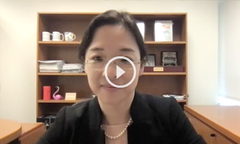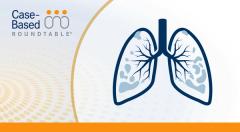
EGFR Therapies Fail to Benefit Patients With NSCLC and Exon 20 Insertions
Joshua K. Sabari, MD, discusses the significance of EGFR exon 20 insertion mutations in patients with non–small cell lung cancer.
Episodes in this series

Joshua K. Sabari, MD, assistant professor of the department of medicine at NYU Grossman School of Medicine and medical director at NYU Langone Health, discusses the significance of EGFR exon 20 insertion mutations in patients with non–small cell lung cancer.
EGFR exon 20 insertions are a rare type of EGFR mutation that does not respond well to the standard treatment of osimertinib (Tagrisso) for EGFR exon 19 and 21 mutations, though Sabari says that a higher dose of osimertinib does have a 20% to 25% response rate for patients with exon 20 insertions.
The standard of care in the first line is platinum-based doublet therapy with pemetrexed plus either cisplatin or carboplatin. Immunotherapy has been investigated, but according to Sabari, the median progression-free survival (PFS) for patients receiving pembrolizumab (Keytruda) is only about 2 to 2.5 months. In addition, immune-related adverse events (irAEs) associated with immunotherapy when combined or followed by EGFR tyrosine kinase inhibitors (TKIs) can be especially dangerous.
Two targeted therapies have been approved in the second line specifically for patients with an EGFR exon 20 insertion. Amivantamab (Rybrevant) is an intravenous EGFR/cMET bispecific antibody. Mobocertinib (Exkivity) is an oral therapy with a different mechanism of action, and is an EGFR HER2 exon 20 TKI.
TRANSCRIPTION:
0:08 | What's important to note about EGFR exon 20 insertion mutations is that patients do not respond to standard therapies. So osimertinib at 80 mg, which is a standard FDA-approved dose, is ineffective in this population. We've looked at 160-mg dosage, and we see about a 20% [to] 25% response rate in the population. So it's important that in the EGFR exon 20 insertion population, we're using agents that have activity in that specific setting. The standard of care in the frontline setting remains chemotherapy with a platinum doublet, carboplatin and pemetrexed or cisplatin and pemetrexed.
The utilization of immunotherapy remains controversial. The median PFS for single-agent immunotherapy in this setting—pembrolizumab—is about 2 to 2 and a half months. So not only is it not effective, but we know that there's increased risk of irAEs or toxicities when we then think about using EGFR-directed therapy subsequently. So in my clinical practice, I'm using chemotherapy alone in the frontline setting.
1:16 | In the second line setting, we now have 2 FDA-approved therapies for patients so if you identify an EGFR exon 20 insertion mutation, you can match your patient to either amivantamab, an EGFR/cMET bispecific antibody, or mobocertinib, an EGFR/HER2 exon 20 TKI, a tyrosine kinase inhibitor.



















































